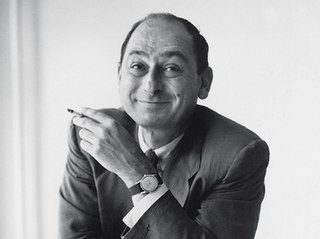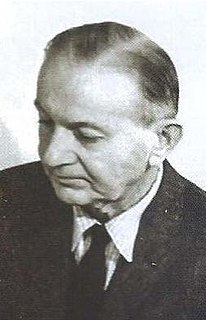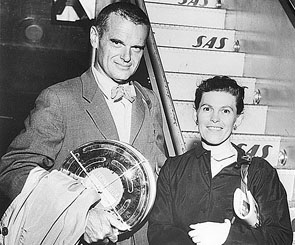
The Eames House is a landmark of mid-20th century modern architecture located at 203 North Chautauqua Boulevard in the Pacific Palisades neighborhood of Los Angeles. It was constructed in 1949, by husband-and-wife design pioneers Charles and Ray Eames, to serve as their home and studio. The house was commissioned by Arts & Architecture magazine as part of its Case Study House program, challenging architects to design progressive, but modest, homes in Southern California. Charles and Ray moved into the home on Christmas Eve in 1949 and never moved out. Charles's daughter, Lucia Eames, inherited the home and created the non-profit organization, the Eames Foundation, in 2004. Still a historic house museum maintained by the Eames Foundation, it was designated a National Historic Landmark in 2006 and serves as a pilgrimage site for nearly 20,000 visitors a year.

George Nelson was an American industrial designer. While lead designer for the Herman Miller furniture company, Nelson and his design studio, George Nelson Associates, designed 20th-century modernist furniture. He is considered a founder of American modernist design.
Herman Miller, Inc. is an American company that produces office furniture, equipment, and home furnishings, including the Aeron chair, Noguchi table, Marshmallow sofa, and the Eames Lounge Chair. Herman Miller is also credited with the 1968 invention of the office cubicle under then-director of research Robert Propst.

The Eames Lounge Chair and ottoman are furnishings made of molded plywood and leather, designed by Charles and Ray Eames for the Herman Miller furniture company. They are officially titled Eames Lounge (670) and Ottoman (671) and were released in 1956 after years of development by designers. It was the first chair that the Eameses designed for a high-end market. Examples of these furnishings are part of the permanent collection of New York's Museum of Modern Art.
The Action Office is a series of furniture designed by Robert Propst, and manufactured and marketed by Herman Miller. First introduced in 1964 as the Action Office I product line, then superseded by the Action Office II series, it is an influential design in the history of "contract furniture". The Action Office II series introduced the concept of the flexible, semi-enclosed workspaces, now better known as the cubicle. All cubicle office designs can be traced back to Herman Miller's Action Office product lines.

Alexander Girard, affectionately known as Sandro, was an architect, interior designer, furniture designer, industrial designer, and a textile designer.

The Eames Lounge Chair Wood (LCW) is a low seated easy chair designed by husband and wife team Charles and Ray Eames.
Dirk Jan De Pree was an American furniture designer.
Max De Pree was an American businessman and writer. A son of D. J. De Pree, founder of Herman Miller office furniture company, he and his brother Hugh De Pree assumed leadership of the company in the early 1960s, with Hugh becoming CEO and president in 1962. Max succeeded his brother Hugh as CEO in 1980 and served in that capacity till 1987; he was a member of the company's Board of Directors until 1995. His book Leadership is an Art has sold more than 800,000 copies. In 1992, De Pree was inducted into the Junior Achievement's U.S. Business Hall of Fame. He was involved with the Max De Pree Center for Leadership at Fuller Theological Seminary since its establishment. He died at his home in Holland, Michigan in 2017.
Charles Ormond Eames Jr. was an American designer, architect and filmmaker in professional partnership with his spouse, Ray Kaiser Eames, he was responsible for groundbreaking contributions in the field of architecture, furniture design, industrial design, manufacturing and the photographic arts.

Ray-Bernice Alexandra Kaiser Eames was an American artist and designer who worked in a variety of media.

Charles Ormond Eames, Jr. (1907–1978) and Bernice Alexandra "Ray" Kaiser Eames (1912–1988) were an American married couple of industrial designers who made significant historical contributions to the development of modern architecture and furniture through the work of the Eames Office. They also worked in the fields of industrial and graphic design, fine art, and film. Charles was the public face of the Eames Office, but Ray and Charles worked together as creative partners and employed a diverse creative staff. Among their most recognized designs is the Eames Lounge Chair and the Eames Dining Chair.

The Wayne State University historic district consists of three buildings on 4735-4841 Cass Avenue in Midtown Detroit, Michigan: the Mackenzie House, Hilberry Theatre, and Old Main, all on the campus of Wayne State University. The buildings were designated a Michigan State Historic Site in 1957 and listed on the National Register of Historic Places in 1978.

The Herman Strasburg House is located at 5415 Cass Avenue in Midtown Detroit, Michigan. It is now known as the Wayne State University Music Annex. The building was listed on the National Register of Historic Places in 1986.
Don Charles Albinson was an American industrial designer who made many contributions to the world of furniture. He worked with Charles and Ray Eames for 13 years, helping develop many of the seminal Herman Miller furniture pieces from the mid century – the bent plywood chair, the fiberglass shell chair, the aluminum group set, and the Eames Lounge chair, to name a few. He later developed the Knoll Stack chair, the Westinghouse office line, an update to the DoMore Series 7 landscape system named Neo 7, the Albi stack chair for Fixtures, and the Bounce chair for Stylex.

The Tivadar and Dorothy Balogh House is a private house located at 49800 Joy Road in Plymouth Township, Michigan. It was listed on the National Register of Historic Places in 2013.

The Eames Molded Plastic & Fiberglass Armchair is a fiberglass chair, designed by Charles and Ray Eames, that appeared on the market in 1950. The chair was intentionally designed for the ‘International Competition for Low-Cost Furniture Design.’ This competition, sponsored by the Museum of Modern Art, was motivated by the urgent need in the post-war period for low-cost housing and furnishing designs adaptable to small housing units.

The Egbert H. Gold Estate, also known as the Marigold Lodge, is a summer estate located at 1116 Marigold Lane in Holland, Michigan. It was listed on the National Register of Historic Places in 1984. The estate is owned by furniture manufacturer Herman Miller, which uses it as a training center and private hotel for its customers.
The Entenza House, also known as Case Study House #9, is a single occupancy residential building in Pacific Palisades, Los Angeles. The address is 205 Chautauqua Boulevard, Los Angeles California, 90272. It was designed by industrial designer Charles Eames, and architect Eero Saarinen for John Entenza as part of the Case Study House Program. The house was designed between 1945 and 1949 and construction was completed in 1950. Named accordingly, Entenza wanted to use the Case Study House #9 for himself as his private residence. He lived within the home for five years before selling it.
The W. Hawkins Ferry House, or William Hawkins Ferry House, is a private house located at 874 Lake Shore Road in Grosse Pointe Shores, Michigan. It was listed on the National Register of Historic Places in 2019.














